I’ve been embracing this whole lighter, faster, cheaper and more effective thing for photography lately, which if you are into SLR based photography can be a little demanding. A complete traditional SLR photography kit can get rather weighty if you are into gear, even a little bit and if you are interested in wildlife photography or bird photography, your kit can start to get very expensive and resemble crew served weapons with heavy duty tripods , 24in long, 10lb camera lenses and bandoliers full of batteries. I’ve been looking for a solution to this and the digiscoping world has had it for some time, but until now, you’ve had to make some serious image quality compromises. This however, is no longer. The last couple of years have seen dramatic improvements in non-SLR camera systems, but a champion system for digiscoping has recently emerged. The best cameras for digiscoping are now, clearly the Fuji X-Series cameras.
I’ll elaborate on that statement below, but first, some background: What is digiscoping? Essentially its using a digital camera connected to a spotting scope or more uncommonly, a telescope. This approach has been increasingly popular over the past decade as people discover the joys of photographing small or distant objects in the natural world. Why do this? Why not just go all SLR with big lenses? Everything is a compromise, but fundamentally, the optics in spotting scopes can be *very* good and yet are smaller and far less expensive than SLR lenses of equivalent focal length. And in the case of the astrophotography community, there are no SLRs with the resolving power possible with a telescope. The problem for the past decade has been 1) how to connect the camera and the scope and 2) the quality of the imaging sensors to collect the available light. In astrophotography, C-mounts and dedicated small, even cooled CCD cameras have been the way to go to reduce noise, but in digiscoping, typically the approach has been to use a point and shoot camera and hand hold it as the small lens/aperture size makes it possible to approximate the eyepiece and “see” what the eye sees through the scope. Essentially, what you are creating with this approach is an afocal system that has no intrinsic convergence or divergence of the image forming beam.
This approach is very difficult to handhold however and leads to uneven success in getting the photograph you want. Different adapters and brackets have emerged over the past few years to make it possible to mount cameras more securely to the scope and ensure a consistent sight picture. There are even mounts for SLRs. The problem with an SLR and digiscoping of course has been size or bulk, not to mention a moving mirror flapping around inducing vibrations and therefore blurring the image at longer focal lengths revealing the distinct historical advantage of point and shoot or mirrorless cameras with electronic shutters. This solution has compromises of course and that has been the image quality of the point and shoot sensors or mirrorless cameras until I’d argue, just this year which could not rival that seen in SLRs. The last year everything changed with image quality on smaller cameras as Sony, Olympus and Fuji released new mirrorless cameras with dramatically improved sensors that create amazing images, and shoot in raw.
Which brings us to the X-Trans Sensor and the X-Series of cameras from Fuji. If you are following along, you know how enamored of this little camera system I’ve become in the last couple of months. Because of its size and the flexibility and inherent qualities in the Fuji imaging sensor, a natural extension was seeing where I could take it with digiscoping.
Its been interesting to watch as whole industries have sprouted up to support various aspects of digiscoping for niche markets like the birding community by creating various mounts for different spotting scopes and camera combinations. I’ve experimented with a number of them and have now come to the conclusion that the absolute best combination is the Fuji X-Series cameras with a T2 adapter that matches the optical path for the APS-C sensor. While I’ve been using this setup for some time to image birds, and planetary bodies like the Sun and the Moon, that older approach did not completely isolate light coming into the camera system and I was still dealing with a point and shoot camera sensor, albeit a good one in the Canon S100. What I’ve done now is moved to a T2 mount from Novoflex to completely isolate the optical path of the Fuji X-Series and mount it directly to the spotting scope which is a far better solution. There are likely other T2 adapters out there for the Fuji X-mount, but the Novoflex is insanely well made and finished and their standards of quality ensure that the focal plane will be right on the sensor where you want it. I should also mention that while I’m digiscoping with the Fuji X-Pro1, the Fuji XE-1 is likely a much better digiscoping camera than the X-Pro1 as it is slightly smaller, lighter, has the same X-Trans sensor and there is no point in having an optical viewfinder on a digiscoping camera.
As soon as I had a Fuji camera in my hand, there were plans to test out the Fuji X-Trans sensor on a spotting scope. But when Fuji recently released the firmware update with focus peaking, that put it over the top in terms of usability for a digiscoping camera. In the animated gif immediately above, you can see how Fuji’s implementation of focus peaking works. Essentially, in this animation, I swept the focus from front to back and the areas of the image that are in sharpest focus are artificially enhanced to increase contrast, showing you precisely where the image is being focused. For digiscoping this is a huge advantage as you are typically out in either very low light or very bright environments and the subjects you are trying to photograph can be small and fast moving. Therefore, anything that helps to rapidly see where your focal plane is, particularly in the difficult light when birds are out and doing their thing is a huge advantage.
While focus peaking on mirrorless cameras has been around for a little while, starting with the Sony NEX cameras back in 2011, the combination of focus peaking with the Fuji X-Trans sensor’s sharpness, color rendition, pixel layout just made the X-Series cameras the ideal camera for digiscoping. Its important to note that part of the reason digiscoping is a more affordable solution to longer distance photography is because focusing with a digiscoping approach is a manual affair as the spotting scope does without the expensive autofocus electronics inherent in SLR telephoto lenses. When you realize this, you can see the inherent advantage to focus peaking.
Aside from focus peaking, there are other advantages to the Fuji X-Trans sensor. While Sony is currently making some of the best imaging sensors out there, amongst mirrorless cameras, the X-Trans sensor appears to have the best dynamic range performance. While I don’t have any quantitative measurements, to my eye and some informal histogram peeping between Fuji, Sony, Nikon (Sony sensors) and Canon sensors, suggests that the Fuji X-trans sensor has the best dynamic range. Images have more visible information in them and there is more room in the raw images to pull details out if desired. And because digiscoping occurs in the very early or late portions of the day, dynamic range is an important factor. As light falls off, you have to compensate by increasing the ISO. But at high ISO, dynamic range is reduced. Fortunately, high ISO performance on the X-Trans sensor is truly impressive. To my eye, the high ISO performance of the Fuji X-Pro1 exceeds that of the Canon 1DX that is spending increasingly more time on the shelf. The two images above for instance were made with the Fuji X-Pro1 at ISO 2000 and 4000 respectively with the second one in completely failing light. These images are essentially straight out of the camera with no additional noise reduction or sharpening to it, yet the image is sharp, has good contrast, detail and color saturation all while preserving information in both highlights and in the shadows. Additionally, the fundamental pixel layout of the X-Trans sensor prevents moiré which can be a problem with repeating, high frequency patterns (like bird feathers). Because of this, there is no aliasing filter on the Fuji X-Trans imaging sensor like on other cameras which degrades sharpness and is absolutely critical when photographing birds.
As I mentioned before, using a dedicated optical coupler like the Novoflex Fuji T2 solution rather that using an eyepiece helps preserve the optical path and reduces lost or stray light from entering or leaving the sensor. This approach gives the sharpest, flattest image formation on your sensor. The other component of this equation is the spotting scope and the adapter from the spotting scope to the T2 adapter that interfaces with the camera. So, for the spotting scope component of this setup, I’ve chosen the Zeiss Diascope with the photo adapter which makes for a 1000mm equivalent lens with the 85mm scope or a 770mm equivalent lens with the 65mm scope, both at f/12. The f/12 is the bad part, but exceptionally good spotting scopes can be had new or used for around $1000, with gorgeous optics that have minimal chromatic or other aberrations, that is not a bad deal compared to spending oh… $14,000-18,000 on an 800mm SLR lens that is considerably bigger, more complex and *heavy*. I’ll get to the weight issue below, but as we talked about above, the good news is that high ISO performance of the Fuji X-Trans is truly exceptional, particularly at higher ISOs. So, in failing light, crank up the ISO on the Fuji cameras without fear. The image of the house sparrow at the beginning of this post was made at ISO 2,500 and looks absolutely gorgeous with nice color fidelity and amazing detail and almost no noise.
Aside from the whole image quality, the biggest advantage to this approach gets back to the whole weight and bulk argument. One of the fundamental appeals of digiscoping as a concept is the ability to photograph wildlife and nature while carrying a minimal amount of gear compared to what you’d have to haul along for an SLR based system. For instance, were one shooting wildlife with an SLR say… 2-10 miles off the road somewhere, you might have an SLR, preferably a pro body, a big lens in the range of 600-800mm and a tripod to hold said camera/lens combination. With my 1DX we are at 3lbs just for the camera. An 800mm lens is an additional 10lbs. The tripod and associated head gear is another 8-12lbs on top of that making for ~23-26lbs just for the basic camera gear, not to mention a backup body or any other lenses or batteries. I’ve carried, literally a 40lb pack full of camera gear up a mountain with Marines half my age carrying the same weight in a combat carry. I earned respect that day, but would gladly have gone without it for half the weight. And when photographing wildlife, I don’t want to be working nearly as hard as I did on that day.
In contrast to that day and the ~40lb pack, for a 1000mm equivalent digiscoping setup, you are looking at a Fuji X-Pro1, adapter, spotting scope, head and tripod combination that weighs less than 8.23lbs or less than 1/3rd the weight of an SLR system. Granted, this is presuming you have a light weight tripod like a carbon fiber model, but its still a dramatically lighter system to have to pack around. It takes some practice and the approach is different than SLR based photography, but you can go lighter, faster and cheaper and if you have more energy to shoot rather than suck air, you are working more effectively. Not to mention you can spend the money you save on nicer tripods and airplane tickets to exotic locales.
Is this an ideal system? Well, no system is perfect and there are some imperfections with this approach and I do have a couple of suggestions for the next revisions of Fuji’s X-System cameras: 1) My main objection with Fuji’s implementation of focus peaking is that when you press the shutter release half way down, focus peaking reverts to non-focus peaking on the preview screen. I see why they did this for image preview purposes and perhaps with more use, it will make better sense. But what I’d like to see is simply, having focus peaking maintained, then show a brief preview of the recently captured image on the back screen after the image has been captured, or make focus peaking display behavior like this an option in the menu. Also, when shooting fast moving objects (like hummingbirds), you can rapidly fill up a buffer when shooting at the Fuji X-Pro1’s 6fps continuous shooting mode and can miss a few shots while waiting for the buffer to clear. Having a faster write cycle would help tremendously and I suspect that the next Fuji X-Series revisions will at least address the faster image write out issue.
While we are talking tripods, for digiscoping I am currently using a Manfrotto 190Cx carbon fiber model with a ball head that is acceptable, but I’m looking for more stability and a smoother, more controlled method of panning and positioning the scope. Gitzo (same parent company) has a solution specifically dedicated to birding with a truly unique head that I am quite intrigued with for all purpose digiscoping. You will find that like shooting with really long SLR lenses, that smoothness of panning and positioning of the scope will be a pretty big deal. Therefore, you don’t want: a “grabby” head or a ball solution that unexpectedly rotates along an undesired axis. You do want: predictable tension and smooth motion on any transitions which will help you to get the sight picture you want. You also want a solution that will let you make subtle adjustments with very little pressure or force which causes all sorts of vibrations and movements of your platform resulting in blurry images. There are a number of combinations, but the one I am eyeballing is a Gitzo Birdwatching head with a Gitzo Traveler tripod. Not a cheap solution though, and I hate to think of what I’ve spent on monopods and tripods over the years, but this will be rigid and lightweight solution while providing all the control needed. And it’ll be the *last* tripod you will ever purchase…<nudge, nudge, wink, wink>.
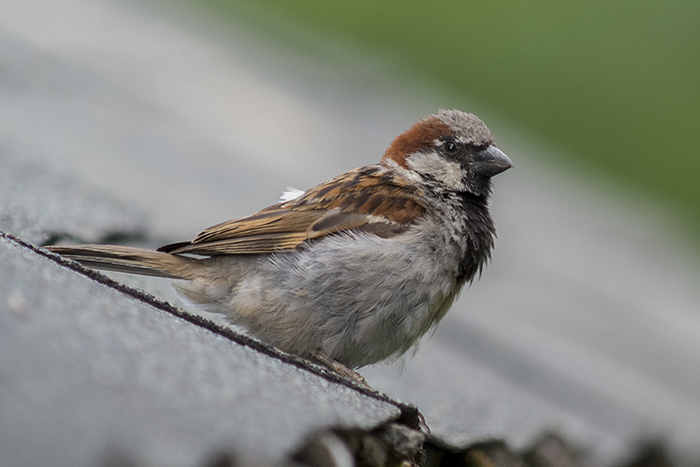
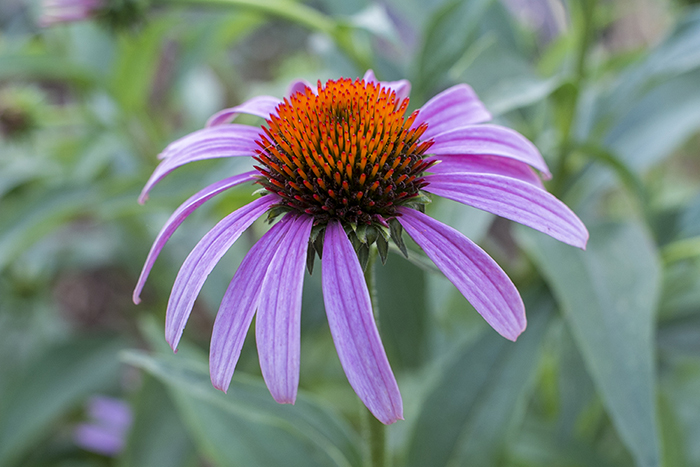
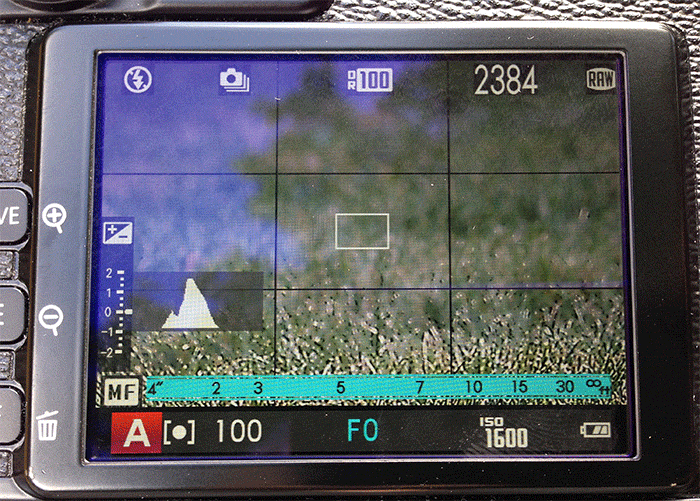
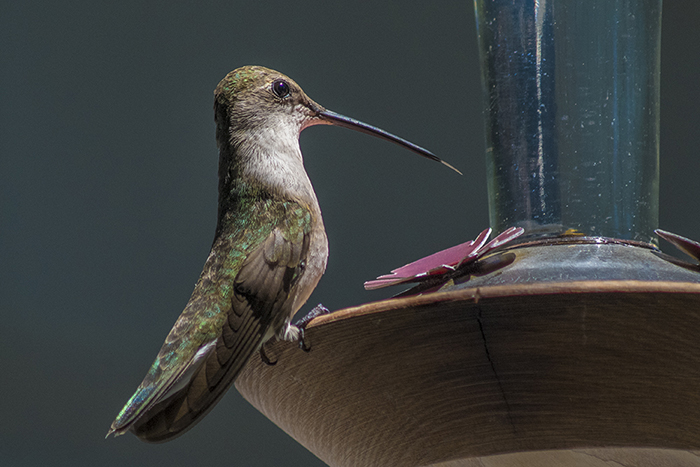
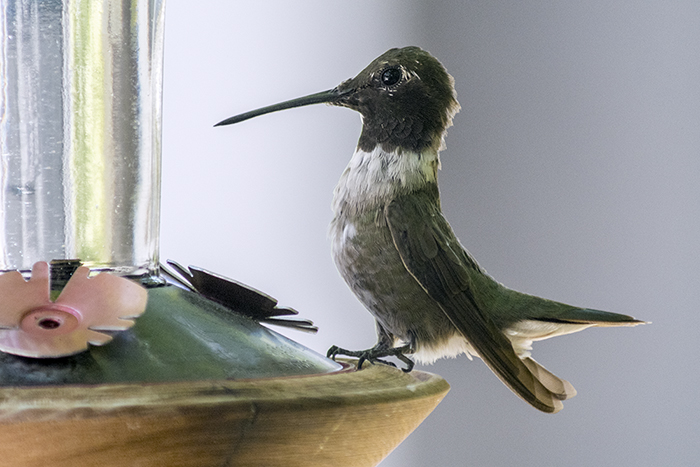
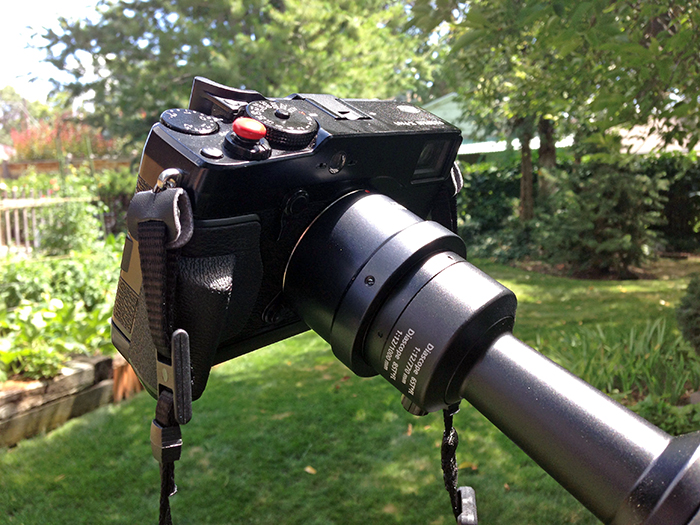
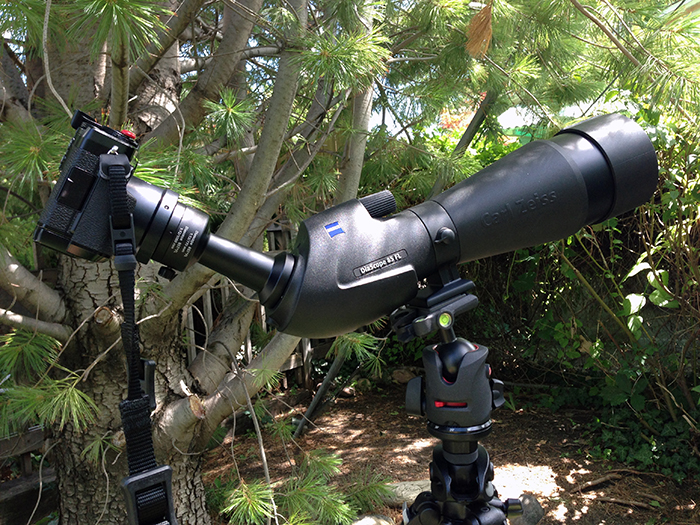
Bryan:
This is looking like the best digiscoping solution I have seen yet. I have been interested in digiscoping as a birder (with a very nice Kowa 773) but never jumped in as I have always been underwhelmed. It was a way to get record shots when all else failed. I don’t know if you had to crop much edge junk, which is typical of most digiscoping I’ve seen. I think it had to take a combination of an excellent quality mirrorless system like the Fuji (not merely the point and shoot that most exponents of digiscoping use) and an expert analytically minded photographer like yourself to sort this out. Digiscoping will be most useful for relatively static or distant subjects and excellent lighting, and the tripod is mandatory as most spotting scopes are not fast at all. You know yourself that fast glass is very heavy at what ever focal length (and correspondingly very expensive!). I will check out the Fuji system later and look forward to your further insight. It has great potential! I like it also for its high quality to size ratio.
I have to admit that I recently went the opposite direction and pulled the trigger for a 1Dx. In the Costa Rican rainforest this past February, I was dismayed at how many shots I missed due to the relatively slow focus response of the 7D and its miserable noise above ISO 800. I was relying on posing birds like motmots and trogons and on a tripod and live-view to pull off shots that I liked to keep. Forget about fast movers like tanagers or antbirds. Also, our guide was down on flash so I used that as a last resort. I am also loving the return to full frame after 10 years of APS-C! Its first real outing will be to Newfoundland this rest of August. Perhaps I ‘ll get some nice puffin or whale images?!
Thanks for your excellent analysis!
Thanks for the comment Michael.
You have hit on the major weakness of the Fuji system, particularly with respect to digiscoping and that is the focus. As you now know, the 1DX is an autofocus magician. I shot a couple of soccer games with it and was absolutely stunned at how fast and effective the autofocus was. In really challenging lighting situations with fast moving small birds, the 1DX will likely capture more “good shots” that are in focus than the digiscoping solution, that is for sure. Also, SLR based approaches to rapidly finding “targets” are simply faster and more intuitive than digiscoping approaches. Now if Canon would just get off their backsides and come out with a new 400mm f/5.6 (or F/4.0) with IS or a new 100-400, that could really be a nice birding solution. I was super thrilled with the 200-400 concept, but it is an 8lb, $12,000 lens. I can’t swing that on an assistant professors salary, for sure.
Following this along, the biggest problem that the SLRs have are going to be cost though followed by size and weight. I’m not ready to abandon the SLR equipment and in fact, will be using it this weekend for a gig. But we can’t keep going up in size for the SLR stuff.
The good news for you if you want to experiment however, is that there are T2 mounts for that super sweet Kowa 773 I believe. You can always check it out for relatively few dollars if you get a T2 converter and one of the lower cost Fuji X-series cameras. As I said, for digiscoping, the X-Pro1 does not make nearly as much sense as the X-E1 or the X-M1.
As far as sensor noise… I gotta say that the Fuji X-series sensor, I believe has better high ISO performance than the 1DX which totally stunned me.
Hola:
Gracias por compartir la experiencia.
Poseo una Fuji X-E1 y me gustaria llegar con ella a 1000mm. ¿Cual seria el material exacto que has utilizado?. ¿Valdría con comprar el adaptador Novoflex T2 y el telescopio Kowa 773?
Un saludo
Usted va a necesitar un adaptador T2 seguro. Sin embargo, tendrá que ser hecho con algo más, como el TSN adaptador Cámara Varifocal PZ Kowa la interfaz con la Kowa 773. Nunca he usado el adaptador de Kowa, sino al alcance 773, usted debería ser capaz de llegar a 1000mm.
Gracias.
De nada.
“The f/12 is the bad part, but exceptionally good spotting scopes can be had new or used for around $1000, with gorgeous optics that have minimal chromatic or other aberrations”
hi, I have a X-E1 and find your article very good and inspiring me to start with digiscoping.
What other spotting scopes are available that you can recommend? I looked at the Zeiss Diascope but they are all around $2000 for either the 65 or 85T.
thanks
Hey Johann,
There are a number of companies that make good scopes. Kowa, Zeiss, Leica, Vortex, Meopta, etc… A good spotting scope is going to be a little expensive. Less expensive scopes can be had from Nikon, Celestron and a few other companies. Aside from optics, you need to make sure you can connect your camera to them with an adapter. Not all companies make an adapter for their scope for T2 mounts.
What I’d suggest is to wait for a sale on a good scope. Save your money and on occasion, there are some screaming deals to be had. I got mine as a demo unit from http://www.eurooptic.com that was several hundred dollars cheaper than new, but you can’t tell the difference from new. These sales of demo units happen after big optical or outdoor shows.
Thanks Bryan for the quick response and informative answer.
How would you rate your Zeiss diascope compare to other models at 1000mm?
Can you please list the exact parts from the photos of your equipment?
Lastly you mention that both Zeiss scopes are F/12. Why do you specify this as bad, and can you please elaborate on this for me a bit?
Excited about this new opportunity and look forward to more development on this post.
I see the Fujifilm EX-2 is coming out soon which looks has higher continuous shooting so should hopefully help on faster write out issue you mentioned.
1) Fuji X-Pro 1
2) Novoflex T2 adapter for Fuji X-Mount
3) Zeiss 85mm Spotting Scope
4) Zeiss Photo Adapter
5) Tripod (its worth it to save money and buy a nice one)
With respect to f/12, that means the aperture with this setup is fixed at f/12 which means that a moderate amount of light will get through. In low light, you are going to have to push the ISO of the camera up a bit to compensate for the fewer photons that are getting through vs. what a faster lens would get. f/12 is not terribly bad, but its not the f/4 that very nice SLR lenses have. Though a spotting scope solution is also 1/10th the cost or less compared with a $14k or more SLR based solution. There are always tradeoffs, but the spotting scope solution really is fun.
Bryan, thank you for your very informative blog on this subject. I have a Fuji XE-2 and a Vortex Razor 85mm scope. I’d like to be able to eliminate the camera lens from the system. Do I understand correctly that I’d need: (1) an X-mount to T-mount adapter and (2) a T-mount to scope adapter to bring this off? I don’t understand how T-mount adapters work, but I guess the scopes focusing ends up putting the focused image in the correct plane (on the sensor) right? Please help a noob understand.
Hey John,
Yeah. You need to get an X-mount to T2 adapter and then a T2 adapter to your scope. A T2 mount adapter is simply a bit of metal machined to fit the bayonet type mount of the camera where the lens goes in on one side and threads on the other to interface with an adapter on your scope. The adapter is designed for your camera to be long enough to match the focal plane of the sensor. T2 mount adapters are ways of universally interfacing with a common adapter so that you can put cameras on all sorts of optics like spotting scopes, microscopes, telescopes, etc…
Mille grazie!
Prego.
Remarkably clear and well-written post…I have the Leica Apo-Televid 77 scope and the Fuji X-E2.What’s my total shopping list to make this work, please?
Many thanks!
Thank you. You will need a Leica photo adapter. This one works with the 82 or 65. I don’t know if it will work with the 77: http://www.bhphotovideo.com/c/product/893286-REG/Leica_42306_SLR_Photo_Adapter.html Then you will need a T2 adapter for your Fuji. I used this one: http://www.bhphotovideo.com/c/product/888380-REG/Novoflex_fux_t2_Adapter_for_T2_Mount.html
This is excellent info, thanks Bryan. I have been adding Fuji (X-E2 and X-T1) to my Nikon arsenal for a while and I agree they should be good for digiscoping.
I have the Pentax PF-80ED but the only adapter I can find is the OEM which is for a Pentax K mount. Do you think this would work with a Novoflex K to Fuji X adapter? It is an expensive combination but the only other alternative I have found is to use the Fuji lens (e.g. 27mm) with a filter step ring that would connect the lens to the Pentax eyepieve (43mm).
Hey Jeff,
I honestly have no idea whether the Novoflex K to Fuji adapter would work. If you try it out, post a comment here and let folks know, eh?
Bryan
Thanks for this which helped me use my XT-1 for digiscoping. I have the camera mounted without a lens on the telescope. It worked superbly until I downloaded the latest Fuji 4.0 firmware. Now I cannot make the shutter work. Presumably the new focusing system is the cause. Please advise!
Bob
Hey Bob,
I’ve not downloaded the latest 4.0 firmware yet. I’ll try it this weekend when I can get a few moments and see if there are problems. It does surprise me to hear that you can’t make the shutter work though. The 4.0 update should not have altered any functionality there.
Thank you Bryan. I’ll play about a bit more and see what I can discover.
The 4.0 firmware converts the camera into something significantly better. Focus is now superb; up to 1/32,000th sec shutter speed; macro function removed because the camera now automatically selects it when necessary.
What a superb concept this is. Buy something excellent and download undreamt enhancements free once a year! What a revolutionary (and evolutionary!) step forward in retailing an item.
With kind regards and thanks again for this blog,
Bob
Its a shame Vortex dont make something like the Scoped adapter you use, I’m struggling to get my Fuji xt1 and -Vortex Razor HD 20-60×85 Angled to work
Because i have to use the lens on the xt1 connected to the eyepiece on the scope, would love to remove the lens and eyepiece like you have, But
Vortex only do the eyepiece adapter, which is a shame
But loving your set up. very nice.
regards
josh
Hey Josh,
In your case, it may be easier to use a point and shoot camera with the Vortex… Those results are not bad.
thanks for the reply, one more question though, how do you zoom the scope when using the eyepiece and using the adapter
regards
josh
I generally pick a focal length, then zoom the camera to where I want it, like I did here: http://prometheus.med.utah.edu/~bwjones/2012/05/ring-of-fire/
But if you haven’t got a lens on the camera, how?
Im not sure i understand, images 6 and 7 show your set-up without a lens or eyepiece?
regards
josh
That is a point and shoot camera in image: http://prometheus.med.utah.edu/~bwjones/wp-content/uploads/2012/05/Zeiss-spotting-scope-digiscope.jpg The lens is retracted into the camera in that image.
sorry i was referring to the none point and shot camera, your fuji x camera, how do you focus that if you have no lens or eyepiece.
Oh, there is a focus adjustment on the spotting scope itself.
Very interesting suggestions and advices you give Bryan! May I ask a shopping list as wel :-)? I have a Fuji XA1 and a compact Nikon Fieldscope ED50.
I am looking quite sone time already to find a good solution.
Thanks!
Willem
I don’t know anything about the nikon Fieldscope or what options there might be for that. On many scopes however, you can mount a T2 adapter. Then you simply need a Fuji to T2 adapter.
Thanx, I will try find a T2 solution for the Fieldscope.
Best Willem
Hi Bryan, I’ve just recently bought a opticron hr 80 ed with the view of getting back into bird watching. Also, now that i have a bit more time on my hands, have decided to get back into photography, which until now has been somewhat of frustrating affair with a vast array of lenses required for the job, until now. Last year i was given an xe2 as a present from my better half, just to get me out of her hair i think! However since reading reviews on scopes I’ve now realised the possibilities of being able to couple both bird watching and photography together, quite literally. How exited am i. Now leads on to why i need your help if you’d be so kind. Since the purchase of the scope I can’t seem to find the equipment to couple the xe2 to the opticron hr80ed, I’ve tried looking at forums to get this info. But alas to no avail. Would you know what i need to get these to together? Kind regards Mark
Hey Mark,
Sorry for the delay in responding. Its been a crazy week. I think the opticron is the same scope as the Zeiss. I don’t know if the SLR adapter mount will work or not.
Hi Bryan,
Your advise is valued and saves a lot of time and money.
I have a Fuji X-T1 and Nikon ED 82 with 25 – 75x eyepiece that I want to use for digiscoping.
From your blog it appears I need to get an X-mount to T2 adapter and then a T2 adapter to my scope?
Using the above there is no camera lens nor eyepiece involved. Is the telescopic length then fixed? (ie 1000mm). Am I correct to say that the scope focus ring is then used for focussing? I also assume the full view is visible in the view finder or LCD screen of the camera.
Your guidance is appreciated.
Regards
Brendes
Hello Brendes,
Sorry for the delay in responding. Have been at a meeting, out of town. I do not know how to interface with that particular scope to a T2 adapter. That said, I don’t do much digiscoping anymore in favor of the new Fuji 100-400 lens and the 1.4 teleconverter. See this entry for details: http://prometheus.med.utah.edu/~bwjones/2016/04/fuji-100-400mm-f4-5-5-6-r-lm-ois-wr-goes-to-the-zoo/
4 Sept 16
Byron,
I admire your blog.
I am late in my interest in “digiscoping” and I sense the wave has crested. At this late date I am interested in connecting the camera I have ( fuji X100s) with a small lightweight scope (Vortex Razor HD 11/33 50). Is the fixed lens x100s usable and the effort worthwhile? What would I need?
It is cheaper than buying Fuji Xpro2 and Fujinon 100-400 lens.
Thanks.
I have not tried digiscoping with the X100 series. It might work. But honestly… That 100-400 is just blowing my mind. See: http://prometheus.med.utah.edu/~bwjones/tag/fuji-100-400mm/ for examples.
Thanks.
Hi Bryan,
great post! such an enlightening. i am using fuji x-e2 right now. do you have a list of telescope which can work with the T2-FX adapter?
many thanks bro.
Thanks for this informative article. I am just looking at getting into this, I have a Fuji X-Pro2 with a 100-400mm lens, which is quite heavy for me now…
I am thinking of getting a something like the KOWA PROMINAR – Straight Body or Celestron Ultima.
would these be ok as a starter kit? what another parts, like adaptors would I need?
Paul
Hey Paul,
Honestly, the Fuji 100-400mm lens is a lighter setup than most digiscoping combinations which is why I almost always use the Fuji 100-400 for birding these days. If you do want to go with a digiscope approach the Kowa is probably a better bet given their support of digiscoping in the past. Leica has also really stepped up in the digiscoping arena.
hi sir,..i m using fujifilm x t 100. can i use digiscoping?
Hey Pranesh, the Fuji X-T100 should be able to adapt to any spotting scope through a T-mount adapter, just like any other X-mount lens Fuji camera.